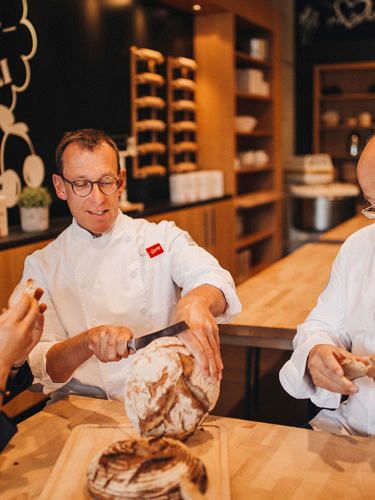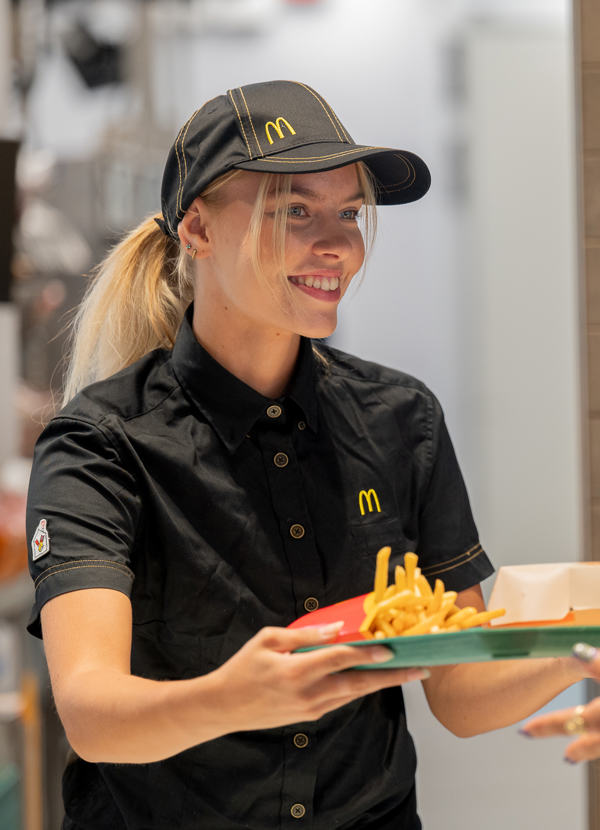Until we met JEROS, we had two full-time employees to fill and empty our old tray cleaner for 7000 trays daily. Manually! Now it's all done automatically! And as a result, we currently only have one employee to clean all our trays – and it's more or less a secondary task next to his other work.

Automated, rapid cleaning and oiling of baking trays save valuable time.
A baker's passion for tradition and innovation

The Challenge at Bäcker Görtz
Producing large quantities of high-quality bakery products daily requires an equally large number of baking and perforated trays, all of which must be kept spotless. After all, there’s no greater quality issue than discovering that the bottom of bakery products is dirty—something that often goes unnoticed until customers unpack them at home.
"We've always been meticulous about ensuring the cleanliness of our baking trays. For many years, two employees alternated, spending 15 to 17 hours a day manually loading up to 7,000 baking and perforated trays into our previous throughput tray cleaning machine," explains Frank.
As the company continues to grow, bringing an increase in the number of trays to be cleaned, Frank recognises a clear need for greater efficiency.
On one hand, Frank and his assistant, Tim Büsch, wanted to reduce the monotonous and physically demanding tasks for their employees. On the other hand, they aimed to introduce more variety in their team's activities.
Additionally, after years of heavy daily use, the old system had reached the end of its lifespan, with the cleaning results no longer meeting their standards.
This challenge prompted them to explore how similar businesses were handling their tray cleaning processes.
Learn more about the fast and efficient cleaning of baking trays with JEROS's tray cleaners ⇨
The automated tray cleaning system transforms the daily task into a quick and effortless process.
After exploring various system options from different manufacturers, none of which met their needs, Görtz and Büsch discovered the solution almost by chance during a visit to the Heitzmann bakery in Bad Krozingen.
There, they encountered the automated tray cleaning system from the Danish manufacturer JEROS, which included the JEROS 9020 tray cleaner and a new automatic feeding system.
“We immediately recognised that this combined system was the perfect solution for our tray cleaning needs. Apart from when loading or unloading, the trays are not manually handled,” says Büsch. "We then contacted JEROS’s sales representative, Mr. Glania, who visited us right away to understand our requirements, ensuring that these could be incorporated into the machine’s configuration at the manufacturer’s factory."
In response to Görtz Bakery’s request, JEROS made a key adjustment: they increased the feed height of the cleaning machine by 20 centimetres, allowing it to accommodate around 170 trays and providing a more ergonomic, back-friendly working environment.
The article continues below ⇩

Achieve these benefits with an automated tray cleaner featuring automatic tray insertion:
- Cleaning and oiling of 150 baking trays in 15 minutes
- Cleaning baking trays WITHOUT the use of water or chemicals
- A double pre-scraper system that optimises the cleaning of the baking trays
- An electricity consumption of 1.1 to 1.5 kW per cleaning is equivalent to the consumption of a vacuum cleaner at home.
Görtz Bakery Receives a Tailored Tray-Cleaning Solution
Unlike standard tray trolleys, which only allow trays to be accessed from the top, Görtz Bakery worked with JEROS to create custom constructions featuring hinged work surfaces and side openings for easy tray removal.
"This makes handling much simpler. The trolleys can be easily moved to the relevant production area, quickly converted into a work surface, and trays can be loaded with minimal effort," explains Frank Görtz.
Once the tray cleaning system was ready for installation, the setup process went smoothly, including commissioning by the service technician.
"Since then, only one employee is required to clean all the trays. What used to take up an entire day is now a secondary task that can be done alongside other duties. He’s also now involved in preparing pastries, which he enjoys," says Büsch.
The article continues below ⇩
Learn more from our visit at Görtz Bakery




The Loading of Baking Trays
After the products are shaken off the perforated and baking trays in the dispatch area, the relevant worker places them into one of Görtz’s transport trolleys, which can hold up to 170 trays, with the baking side facing upwards.
Once the trolley is full, an employee moves it into the automatic loading unit, which is housed in stainless steel, and closes the safety door. The employee then presses the start button on the control panel, which triggers the automatic latching of the trolley into place using a pneumatic lock. A laser sensor then detects the trays, and a pneumatic lifting frame with eight special silicon vacuum-suction membranes lowers onto the top tray or perforated trays along the two-centimetre-wide edge.
The integrated vacuum pump generates suction to securely grip the tray. The pneumatic lifting frame then lifts the tray and, after compensating for vacuum precision, transfers it to the feed opening of the docked JEROS 9020 industrial tray cleaner, where the actual cleaning process begins.
The Cleaning Process
The JEROS 9020 industrial tray cleaner is specifically designed for bakeries that process 800 to 1,000 trays per hour. The majority of the machine is made from easy-care stainless steel, while the large, pneumatic top cover and side panels are constructed from solid plastic to reduce noise and enhance sound absorption.
The JEROS 9020 model is equipped with six precision-cut rotating brushes, each fitted with durable bristles tailored to the material being cleaned. These include three primary cleaning brushes with replaceable side brushes for cleaning the turned-up edges of trays, a brush for cleaning holes, and two additional brushes for final cleaning.
Once a tray is placed in the machine by the loading unit, it first passes through a dual pre-scraper that removes any coarse debris. The first pair of feed rollers then push the tray through the main cleaning brushes, which rotate in opposite directions above and below the tray, effectively pre-cleaning both sides.
The second set of feed rollers grips the tray and guides it to the remaining main cleaning brushes, where any remaining coarse dirt is removed. For perforated trays, the third set of transport rollers holds the tray in place while a specialised rotating brush cleans the holes. Dirt is pushed upwards from beneath and is removed by the subsequent cleaning brushes. The final stage of cleaning is completed as the tray passes through the "finishing brushes."
Before the cleaned trays are dropped onto the tray trolley at the rear of the JEROS 9020, they pass through an adjustable oil-spraying unit, developed in collaboration with Boyens Backservice. Six "Armix" nozzles evenly and precisely apply a thin layer of oil.
"This system, along with the hygienic KEG deposit barrels, is a perfect solution that saves on release agents and reduces costs," Tim Büsch reports.
Investment with a positive impact







